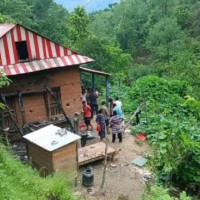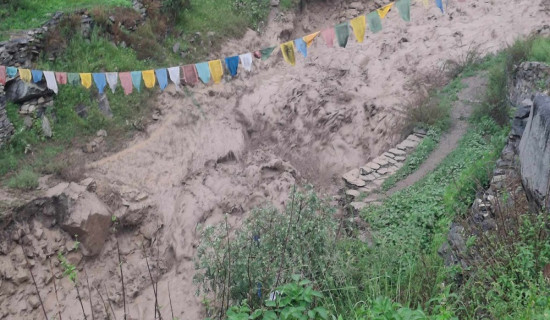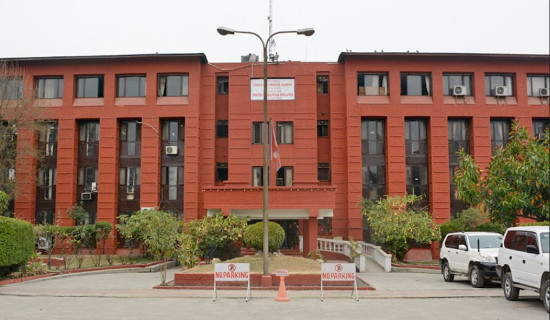- Tuesday, 29 July 2025
Arjun Chaupari’s Navagraha Temple: A growing religious tourism hub
By Radhakrishna Dumre,Syangja, Feb. 23: Located within the serene Jalbaraha forest of Arjun Chaupari Rural Municipality-1, Syangja, the newly constructed Navagraha Temple is fast emerging as a religious tourist destination.
As Nepal’s first temple dedicated exclusively to the nine celestial bodies, it has not only filled a long-standing spiritual gap but has also revived the village’s vibrancy.
The Navagraha Temple stands as a testament to the rural municipality’s vision of promoting religious tourism.
Built within a religious forest, Jalbaraha, it aims to attract devotees and visitors seeking spiritual solace.
According to Rural Municipality Chairperson Prakash Tiwari, Nepal lacked a temple solely devoted to the Navagraha, leading to the creation of this sacred space.
Prem Dhakal, a businessman from Arjun Chaupari Bazaar, expressed his excitement over the temple’s impact.
“Due to migration, there were very few people in the village. Seeing this level of activity now makes us very excited,” he shared. The increased flow of devotees has brought new life into the village, reversing the effects of depopulation.
The temple gained widespread attention when special worship ceremonies began on February 18, in the runup to Maha Shivaratri.
The rural municipality had announced that the consecration rituals of Nepal’s first Navagraha Temple would be completed on this auspicious day. The temple has seen a steady influx of devotees.
Notable personalities have also visited the temple, adding to its growing prominence.
Former Nepali national cricket team captain Sandeep Lamichhane visited with his parents and expressed his joy at seeing his hometown evolve into a religious hub.
Additionally, religious discourses from figures like Dr. Swami Keshavananda and Chaitanya Krishna have enriched the spiritual experience for visitors.
The temple’s location along the Siddhartha Highway positions it as a convenient stop for Indian tourists en route to Muktinath.
Many Indian pilgrims traveling through the area have already taken notice of this sacred site.
Religious leader Chaitanya Krishna highlighted the temple’s significance, emphasising that Nepal had previously lacked a dedicated Navagraha temple.
The nearby road leading to Sirubari Homestay, Nepal’s first homestay, is also expected to enhance religious tourism in the region.
Transforming village landscape
Like many rural areas, Arjun Chaupari had been witnessing a steady decline in population due to migration. Many homes remain locked, and economic activities have dwindled.
However, the establishment of the Navagraha Temple has sparked a remarkable transformation.
Chairperson Tiwari informed that the temple has become an example of revitalisation for the village. Thousands of devotees now visit daily, participating in Gita discourses and religious festivals.
Unique architectural and spiritual features
The Navagraha Temple stands apart not only for its religious significance but also for its unique architectural features.
Hindus traditionally worship the Navagraha in their homes, and to honour this tradition, the rural municipality has built a Navagraha Shakti Peeth for proper ritualistic worship.
Surrounding the temple are sacred Peepal trees, enhancing the spiritual atmosphere. The temple’s main pillar, a striking nine-arm structure, stands at 27.7 feet. At 27 feet, an upward-facing cosmic deity statue is revealed only once a year on the day of Ganesh Chaturdashi, making it a rare sight for devotees.
Additionally, a hexagonal structure within the temple complex houses a Panchamukhi (five-faced) Shiva Linga, reminiscent of the one in Pashupatinath.
Statues of other revered deities, including Ganesh, Kuldevata, Laxmi, Kal Bhairav, Hanuman, and Durga Bhawani, have also been installed.
Visitors to the temple enter through a single entrance and complete nine circumambulations around the Navagraha shrines before exiting.
The temple’s nine-arm pillar features planetary symbols at 13 feet, with a 14-foot-high structure above it.
At the pinnacle, a solar planetary deity faces the sun, a symbol of cosmic energy. The deity statues were crafted in India under the guidance of Hindu astrologers, ensuring authenticity in their representation.
The temple will remain open only on Saturdays. However, for the convenience of worshippers, one of its nine circuits will be available for worship on other days.




-square-thumb.jpg)


-(1)-(1)-square-thumb.jpg)








